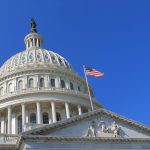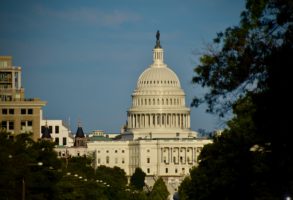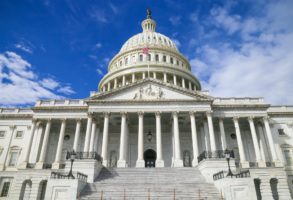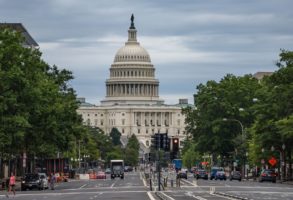Published April 27, 2016
On Wednesday, April 27th, EPPC Senior Fellow James C. Capretta testified on a panel at a hearing held by the Senate Budget Committee. Video of the full hearing is available here. Mr. Capretta’s written statement is available in PDF format here and is pasted below. The testimony of the other witnesses (Barry Anderson and Stan Collender) is available here and here, respectively.
Mr. Chairman and members of the committee, thank you for inviting me to participate in this hearing.
The nation is facing serious fiscal challenges and has been for many years. The Congressional Budget Office’s (CBO) most recent long-term budget projections indicate that accumulated federal debt will reach 100 percent of the nation’s gross domestic product (GDP) in about two decades’ time. This is an unprecedented deterioration in the nation’s fiscal position. From 1957 to 2008, federal debt never exceeded 50 percent of GDP, but it now exceeds 70 percent of GDP. Over the next decade alone—2017 to 2026—the CBO estimates that the federal government will borrow another $9.3 trillion, and that assumes spending on national security will fall to levels not seen since before World War II.
In my testimony today, I will discuss three aspects of the current process that require attention and reform:
- The uncontrolled growth of mandatory spending;
- The importance of keeping focus on long-term fiscal policy; and
- The absence of a process for facilitating legislative and executive agreement on the budget.
The Role of Mandatory Spending
The fundamental problem with the nation’s finances is the runaway expense of mandatory spending programs. In 1962, the federal government spent 4.7 percent of GDP on benefit transfers and other automatic spending programs, such as Social Security, unemployment insurance, and welfare support. By 2013, spending on these mandatory programs had risen to nearly 13 percent of GDP.
Instead of forcing policymakers to confront the problem, the current budget process shifts financial pressures off of mandatory spending and onto other portions of the federal budget. As spending on entitlement programs soared since the early 1960s, funding for annually appropriated (or “discretionary”) accounts, especially defense, fell precipitously, from 12.3 percent of GDP in 1962 to 7.2 percent in 2013.
Sooner or later, and probably sooner, the unsustainable nature of the current state of fiscal affairs will force change. A crisis might be precipitated by an international event that exposes the current defense budget as woefully inadequate to confront the threats to the nation’s security. A quick upward adjustment in defense spending could set in motion changes in perceptions that lead to large increases in interest rates.
It would be far better for the country if elected leaders did not wait for a crisis to act but instead confronted the nation’s fiscal problems with more foresight and planning. The changes in programs would be more gradual and more carefully designed.
Keeping Focus on Long-Term Fiscal Policy
The nation’s fiscal position has deteriorated significantly in recent years, with large deficits and mounting debt. But the most significant threat is not short-term but mid- to long-term. According to the CBO’s latest long-term projections, federal debt will never again return to the postwar norm. Instead, the national debt will rise inexorably and exceed 100 percent of GDP in 2040. The primary cause of unending federal deficits is rapidly rising entitlement spending. By 2040, the CBO expects spending on the major entitlement programs (Social Security, Medicare, and Medicaid), plus the subsidies made available by the Affordable Care Act, to total 14.2 percent of GDP, up from about 10 percent today. That is an immense shift of resources toward consumption-oriented entitlement spending.
Policymakers need to keep their eyes on the long run and the steps necessary to begin closing the immense gap between expected revenue and expected spending. It would be truly unfortunate if Congress and the president pursued a short-term fiscal plan without also thinking through what needs to be done over the longer term. The result could very easily be a temporary reduction in the budget deficit that is quickly overwhelmed by longer-term spending trends.
Unfortunately, the current budget process does not provide policymakers with a clear view of the long-term challenges, nor does it facilitate the kind of decision making that would improve the long-term fiscal outlook.
An Elusive Federal Budget
A related problem is that the executive and legislative branches of our government have parallel budget processes that do not necessarily result in a consensus plan.
Congress expresses its views on the budget in the congressional budget resolution (CBR). CBRs are not laws. Rather, they are concurrent resolutions, which means they are relevant only for Congress. Presidents are in no way bound by them and in fact have often denounced them as containing misplaced priorities. Of course, presidents prepare and submit a budget plan to Congress every year, and those too are often denounced as inadequate by members of the House and Senate.
The parallel budgetary processes of the executive and legislative branches are a reflection of our constitutional structure. The co-equal branches of government each have a substantial role over the federal budget, and there is no legal requirement that they ever fully come to an agreement with each other. Indeed, with some exceptions, it can be said that the federal government never truly operates within a budget because the legislative and executive branches rarely agree on one.
This structure has practical consequences. It is possible, and happens frequently, that Congress will proceed based on one budgetary framework, defined by a CBR, that differs substantially from the framework the president supports. The differences between the two branches get addressed, if they do at all, only when actual spending or tax legislation that is a product of the CBR framework makes its way all the way through the legislative process and reaches the president’s desk. At that point, the president can sign or veto the legislation. Usually, if there is an ongoing disagreement, the anticipation of a veto is enough to bring the entire process to a standstill. This is an important reason why there are regular, drawn-out budget fights between Congress and the president. The two branches spend most of the year working from different budgetary plans, and then there is a mad scramble to provide an ad hoc resolution to the disagreement to keep the government operating.
But even if an ad hoc process works temporarily, that is very different from having in place a budget framework that lasts multiple years and provides financial structure and stability to government finances. The current process does not apply any countervailing pressure to offset the institutional and political tendencies toward budget stalemate that are built directly into our constitutional order.
The Joint Budget Resolution
A possible, partial antidote for budgetary drift, rising mandatory spending, and neglect of long-term challenges might be found with a joint budget resolution (JBR).
Unlike a CBR, a joint resolution must be agreed to by the president and therefore is a law. It thus has the potential to facilitate, and perhaps even pressure, the legislative and executive branches into coming to an agreement on key budgetary aggregates that would govern decisions by both branches later in the budget process.
There are numerous ways to provide for the consideration of JBRs, but the most straightforward option would be to build on the current process. This can be accomplished by amending the current Budget Act rules to allow an optional JBR “spin-off” from any CBR agreed to by both the House and Senate. Congress would not have to pursue a JBR, but if it did so legislation would automatically get sent to the president upon adoption of a CBR, and the JBR would reflect the key budgetary aggregates: total discretionary spending, total mandatory spending, revenues, deficits, and debt. The president could then either approve or veto the legislation.
If the president vetoed the JBR, the process would revert back to what is in place today under the Budget Act. Congress could proceed under the terms of the budget resolution, and engagement with the executive branch would be postponed until later in the year, when the spending and tax bills flowing from that budget were transmitted to the president.
If, however, the president agreed to the JBR and signed it into law, the budget framework contained within it would have the force of law, and both branches would be bound by it.
A JBR covering the full budget would have the capacity to adjust the caps on discretionary spending, impose discipline on mandatory spending, and provide a target for revenues. This would ensure that Congress and the president truly engage in budgetary decision making. There would be clear trade-offs between the key budget categories, as well as projected deficit spending and debt. Congress and the president could choose to put more pressure on mandatory spending programs and thus perhaps ease the pressure on discretionary accounts, or vice versa.
Although ideally a JBR should cover all aspects of federal budget policy, it would be possible to start with an interim step of adjustments just to the discretionary caps. The CBR would operate as it does today, except that, upon adoption of a conference report on a CBR, Congress would have the option of sending to the president a JBR providing for adjustments to the discretionary caps at the levels provided for in the CBR.
This interim step would be important because it would empower the Budget Committees in the House and Senate; they would become the committees directly responsible for establishing these binding caps—a first step toward a real budget process that would bind both the legislative and executive branches.
Enforcement
The JBR concept works only if a sensible enforcement system is attached to it. The caps on discretionary spending are enforced with a well-established mechanism—a sequester of spending above the cap amount.
Enforcing discipline on mandatory spending is of course a more difficult matter. There are several ways to go about this, but whatever approach is chosen should:
- Provide an incentive for Congress to enact reform legislation that avoids the need for an enforced change in spending;
- Set in motion balanced and reasonable adjustments focused on many programs, not just an isolated few; and
- Allow for adjustments to occur over a period of years rather than all at once.
Congress could also choose other approaches to enforcement, such as focusing on the cancellation of future spending increases or planned program liberalizations scheduled to occur in future years.
Toward a Long-Term Budget
While a JBR with sensible enforcement would be a significant improvement over the current process, it will not, by itself, solve the problem of inattention to the long term. An important first step toward addressing that problem would be to get agreement in the legislative and executive branches on how to measure the long-term fiscal obligations of the government. That information could then be used to inform current legislative debates and eventually used to spur legislative action.
One approach would be to establish a uniform definition of the federal government’s long-term unfunded liabilities. In general, this would mean calculating the present value of expected future tax receipts and expected future spending commitments. Long-term forecasts are already done annually for both the Social Security and Medicare programs, and so a large portion of the federal budget can be assessed on this basis with current information. (The latest projections indicate the combined unfunded liabilities for these programs is more than $40 trillion.) These forecasts could be supplemented with assessments of other parts of the budget, especially those that create long-term obligations on behalf of the government, such as pension programs (civil and military and the Pension Benefit Guarantee Corporation) and health benefits.
Once a common measure is established, it could be used to assess legislation in Congress and perhaps also be incorporated into a JBR. For instance, the budget process could be amended to require CBO assessments of how significant new budgetary legislation would alter the unfunded liabilities calculation. Bills that would increase those liabilities could be ruled out of order and thus pulled from consideration unless a supermajority of the members chose to override the rule.
In addition, a CBR could “reconcile” the committees with jurisdiction over the major programs with large unfunded liabilities and thus set in motion privileged legislation to narrow the fiscal gap with corrective legislation. This kind of legislation would not need to show deficit reduction over a 10-year period but over some longer time frame, such as 25 or 50 years.
Conclusion
The United States is facing serious fiscal challenges that will not be easy to overcome. The sharing of budgetary responsibility by two co-equal branches of the federal government makes large-scale and painful change particularly difficult to achieve. Moreover, budget process reforms cannot make political disagreements vanish.
But, if political leaders are inclined to search for an agreement on the budget, a better process could make it easier for them to reach that goal.
James C. Capretta is a senior fellow at the Ethics and Public Policy Center, a visiting fellow at the American Enterprise Institute, and an affiliated Scholar at the Mercatus Center at George Mason University.







